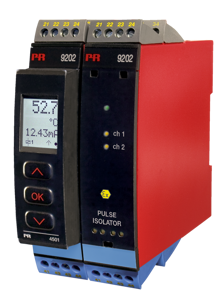Product Spotlight: The PR electronics 9202B Pulse isolator
Learn more about the 9202B pulse isolator. A switch amplifier for both NAMUR and switch input types. See what it can do for you.
a) What is a “pulse isolator”?
- A switch amplifier capable of measuring one or more pulse inputs and providing an identical number of isolated pulse outputs.
b) What is “isolation”?
- The PR 9202B uses transformer and optical isolation techniques to provide 2.6 kV isolation between the input, output, and power terminals. This high level of electrical isolation means that pulses sensed at the PR 9202B input are not electrically connected to the pulses by the PR 9202B output.
c) What type of pulse inputs does the 9202B measure?
- The PR 9202B measures pulses created by contacts and NAMUR sensors.
d) What type of outputs does the PR 9202B provide?
- The PR 9202B can be ordered with either contact or NPN transistor outputs. The NPN output can switch at up to 5 kHz, making this version usable in high frequency applications. For example: Measuring pulses created by a NAMUR sensor that is detecting rotation of a gearbox shaft.
e) Why use the PR 9202B?
- Besides providing isolation, the PR 9202B is a barrier. This means that the module can make an intrinsically safe measurement of contacts and NAMUR sensors mounted in a zone 0/ Division 1 explosion hazard area.
- The PR 9202B limits the level of energy present at the contact or the NAMUR sensor to a low intrinsically safe level, thereby preventing ignition of a flammable atmosphere around the sensor – even if the sensor or the cable is damaged.
- The isolated PR 9202B pulse output can be safely and accurately measured by the user's control system. The high 2.6 kV isolation protects expensive control system components from damage or error caused by high voltage transients, common mode noise, and ground loops.
Learn more about PR 9202B Pulse Isolator

